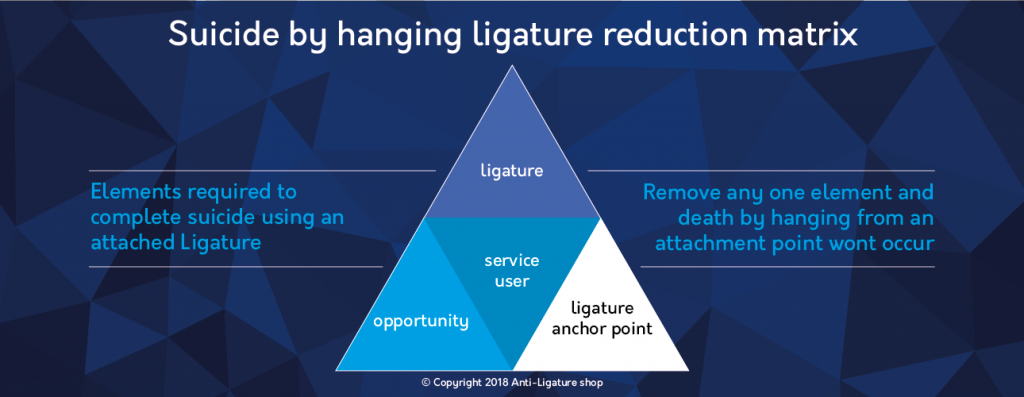
The most common ligature points used are doors (43%) or windows (18%)
The most common ligatures were a belt (35%) or sheets/towels (27%).
Most deaths by hanging occur in unobserved areas. The majority (68%) of deaths by hanging in a single bedroom or a toilet/bathroom (18%).
The majority of inpatient suicides occur when the patient is under intermittent observation. Deaths under observation tended to occur when observation was carried out by less experienced staff or (temporary or agency) staff likely to be unfamiliar with the patient. In many instances policies or procedures (including times between observations) were not followed, for example:
(a) when staff are distracted by other events on the ward
(b) at busy periods e.g. 7-9am
(c) when there are staff shortages
(d) when ward design impedes observation.
References
The University of Manchester and Healthcare Quality Improvement Partnership (HQIP) 2015 The National Confidential Inquiry into Suicide and Homicide by People with Mental Illness Annual Report: England, Northern Ireland, Scotland and Wales 2015
Anything that could be used to attach or secure a ligature for the purpose of strangulation or hanging
Beds
Should be appropriate to the environment (Fixed Anti-Ligature beds in acute settings).
Brackets, picture rails etc.
Consider bracketed and fixings – remove, box in or chase into the wall
Curtain rails for beds, windows or doors, baths and showers
Must have a low weight bearing capacity i.e. be collapsible or fitted flush to the ceiling
Curtain tracking
Curtain wires for nets
Avoid the use of curtain wires – consider alternatives
Doors. door closers and door handles
Electrical conduits/wiring
Should be ‘chased’ into walls, or fitted flush to wall
Exposed pipe work and fixing
Consider height and accessibility
Hinges – doors, wardrobes, cupboards
Consider type of hinge and any gap between door and frame (e.g. consider piano hinge).
Light switch cords
Patient’s lockers/wardrobes
Consider hinges and removal of hanging rails
Radiators
Consider boxing in if appropriate to the environment
Shelving and fixing brackets
Consider the risks
Wardrobes
Consider design, handles, internal hooks, door closing, hinges and any gap created between
Windows and window openings
Design appropriate for the environmental – consider handles, trickle vents, hinges hooks and closers etc.